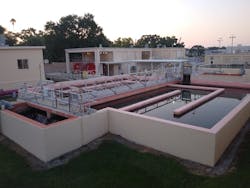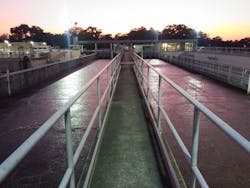About the author:
Cristina Tuser is associate editor for WWD. Tuser can be reached at [email protected].
Location: Pinellas County, Florida
Size: 6 mgd peak average daily flow, 4.695 mgd raw average daily flow
Equipment: Ground storage tanks, elevated storage tank, aeration tanks, SCADA, course bar screen, fine bar screen, grit classifier, submersible variable speed pumps, anaerobic treatment, A2O, clarifier weirs, denitrification filters
The Dunedin Wastewater Treatment Plant (WWTP) is located in Dunedin, a well-established residential community with Scottish traditions, in Pinellas County, Florida. Originally constructed in 1949 as a primary treatment facility, the facility was expanded and modified for secondary treatment in the late 1960s.
A flow equalization tank was also added to the process in 1985, and in 1991, construction was completed on a treatment plant replacement project to meet legislation passed in 1987, which required construction of advanced wastewater treatment with nutrient removal.
The plant is permitted for 6 million gallons per day (mgd) annual average daily flow and current annual raw flows are 4.695 mgd. Current annual reclaim flows 3.23 mgd and 68% of the incoming raw flow is converted to reclaimed water, filling three 2 million gallon Crom ground storage tanks and one 1 million gallon elevated storage tank for a total reclaimed water capacity of 7 million gallons.
The city of Dunedin recently converted to an all liquid feed system for sodium hypochlorite (bleach 12.5%) for disinfection and sodium bisulfite (40%) for dechlorination purposes, which allowed the it to remove all the compressed chlorine gas and the compressed sulfur dioxide gas from the facility. The WWTP became safer for staff and the surrounding residents after the conversion as a result.
Currently, a rehabilitation project is in the works, including: the rehabilitation of four 775,000-gallon aeration tanks as well as new stainless steel aeration piping and valves; the installation of new 9-inch Sanitare diffusers; and the complete removal of all sand and debris from the bottom of the aeration tanks. The total estimated cost for completion of the aeration tank rehabilitation project is $785,000.
A future upgrade will be the replacement of all SCADA and motor control centers, which is estimated to cost $9.5 million.
Influent wastewater enters the plant through 21-inch- and 24-inch-diameter interceptors. The raw wastewater flows through the headworks, which consists of automatic course and fine bar screens, manual back-up bar screens and a grit classifier.
Following preliminary treatment processes, wastewater flows to a wet well from which the water is pumped by up to five submersible variable speed pumps, to either the equalization tank at peak flows or the anaerobic treatment tanks at the head of the anaerobic/anoxic/oxic process.
The remaining wastewater then trickles over the secondary clarifier weirs into a wet well, where it gets pumped to the deep bed denitrification filters. Methanol is added prior to filtering to provide a carbon substrate for the filter denitrification bacteria, according plant managers. A majority of the effluent is pumped into the city-wide reclaimed water distribution system.

